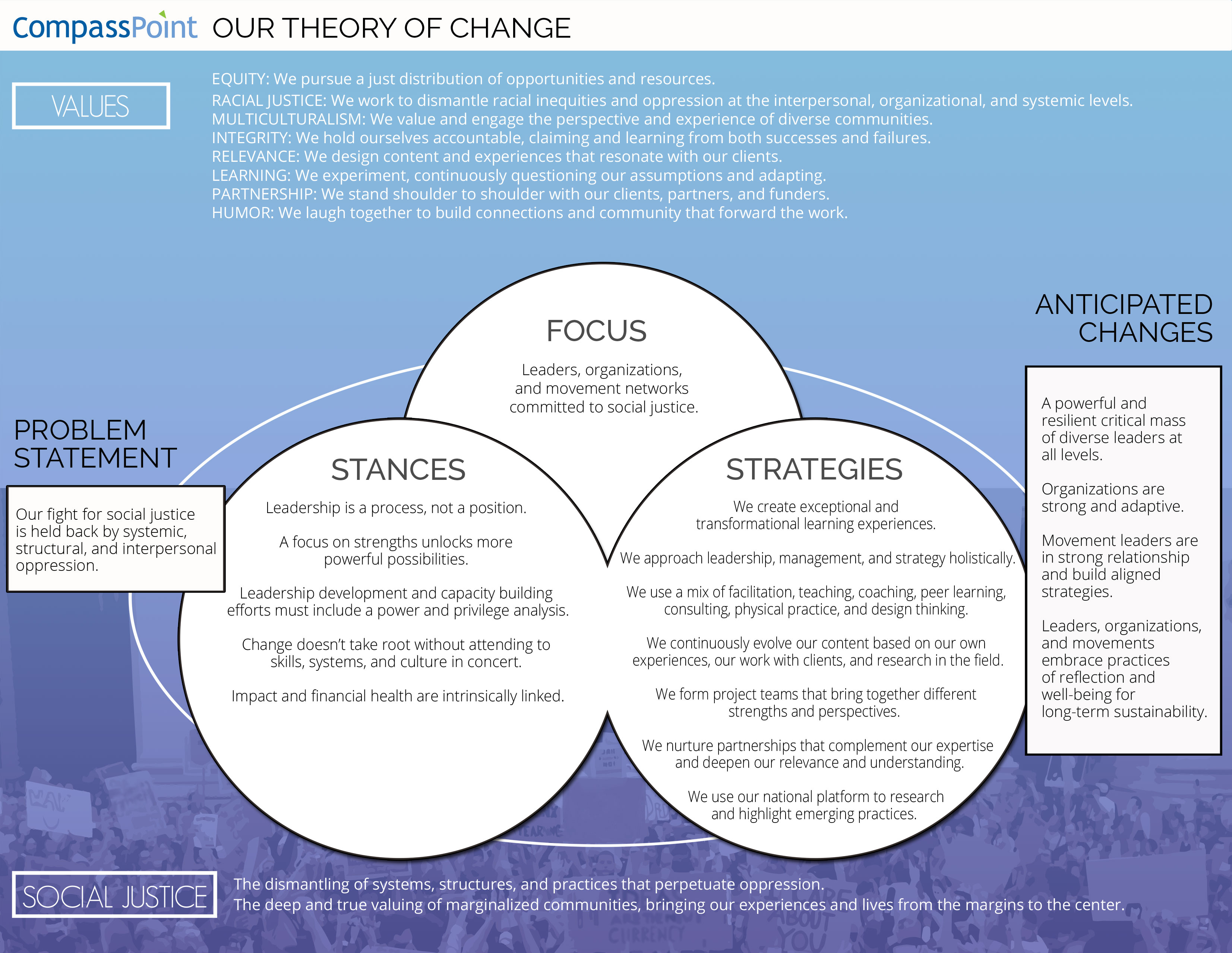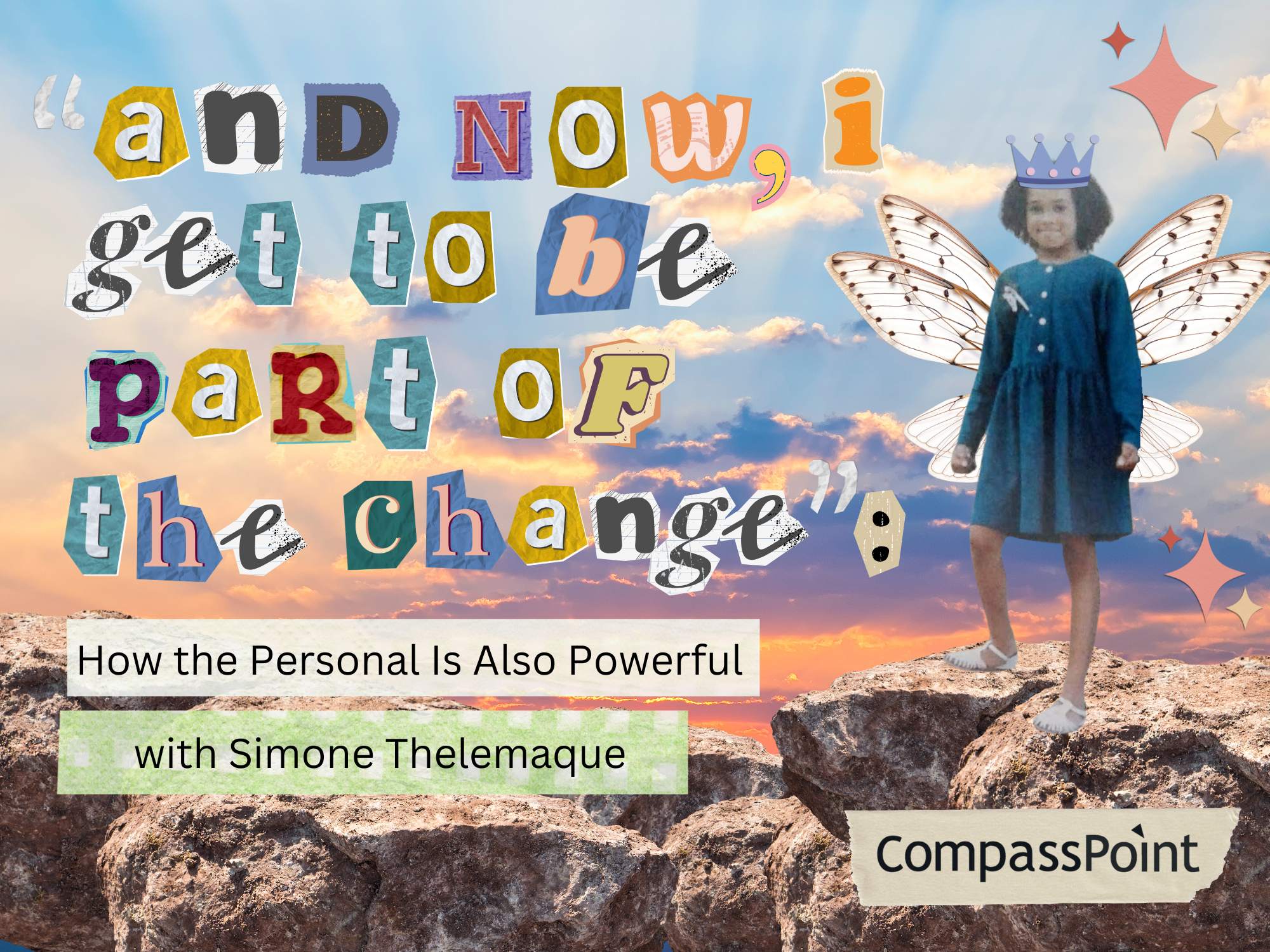Have you ever wondered what a theory of change really is, but been afraid to ask? Well, wonder no more. In this blog, CompassPoint's Shannon Ellis provides a thorough rundown of what you need to know about this strategy tool and how it can be used in your organization.
CompassPoint developed our first organizational theory of change (TOC) in 2011 with the guidance of jdcPartnerships. Through this process, we began to explicitly draw the connections between our leadership development and organizational capacity building work and our collective intention to actively contribute to social justice outcomes. We further revised the language of our theory of change in 2015, becoming bolder and crisper about our values of equity and racial justice and developing deeper clarity about our intended impact.
Since then, we've become advocates for and practitioners of using this approach to guide organizational strategy formation. Using a theory of change approach has shifted—and continues to influence—much about how we do our work. For example, our processes for hiring and developing staff, how we identify and assess opportunities for new projects, and the way we design and deliver our programming all have changed significantly over the past five years.

Of course, working toward justice outcomes is ongoing, often messy, and deeply challenging. Many of us can name where we still come up short on fully integrating the values and stances we have claimed in our theory of change. But the fact that we can—and do—identify those shortcomings and work to resolve them together is exactly what this approach requires of us. Adopting a theory of change means that we are making a collective commitment to continually grapple with the meaning of our work together. It means we hold ourselves and each other accountable to achieving our intended impact, not only to exceptional program delivery.
What is a theory of change anyway?
Theory of change is a "buzzword" thrown about by foundations, evaluators, and consultants (us included!), often referencing very different but lightly affiliated approaches. If you're reading this, you likely either have a theory of change, are frustrated with a theory of change, or are wanting to know what in the world it is before you decide whether or not it would be useful for your organization.
To make it more complicated (but also, perhaps, more compelling), there is not a single, codified way to develop and activate a theory of change. Process and product can look very different, depending on whether it's focused on an organizational, community, or field level—or being led with a primarily evaluative or strategic lens. Still, most TOC processes have a few common elements that distinguish them from traditional strategic planning or program evaluation approaches, including:
1. Focus on achieving impact, not on developing organizations. Organizational development goals can be valuable, but for nonprofits those goals must always be placed squarely in the context of "to what end are we developing this organization?"
2. Recognition that meaningful contributions to social change require ongoing reflection and action throughout an organization. Top-down strategies often don't reflect community needs and can be frustrating to implement to those not involved in developing them.
3. Understanding and valuing the fact that organizations do not create social change alone. Organizations can play an important role, but only within a larger context that engages with and builds from community power, policy change, other organizations' successes, and larger shifts in thought and behaviors. A theory of change process deepens an organization's understanding of its specific role and purpose within that context and how it can both leverage and fuel the momentum outside its doors.
At CompassPoint, we define a theory of change as a way to visually represent an organization's current thinking about how it contributes to desired changes in the world. It represents the conceptual linkage among:
- A clear analysis of the problem your organization exists to address, grounded in the current context of the community, field, or movement that it serves;
- A set of desired, specific changes that your organization contributes to and that would indicate the problem is being resolved;
- Clarity about where your organization focuses its efforts and resources in its contribution toward those changes;
- A description of your organization’s distinctive approaches that contribute toward those changes;
- And the underlying values that guide and inform your organization's work.
When done thoughtfully with effective leadership, a TOC process can fuel staff and constituent clarity about your organization's work in the current environment. All social change work is fundamentally trying to create some kind of positive shift in the world. Developing a theory of change can help your organization surface and make explicit the connections between your efforts and your contributions toward these specific outcomes.
Questions to consider if you're thinking about developing a Theory of Change for your organization
Are we—staff, board, constituents—fully aligned in how we think about the organization's work? It's very possible, even common, for people to work together in service of a common mission with very different ideas about why the work is important and what success would look like. This kind of unresolved dissonance can create frustration and dilute the organization's efforts toward clear outcomes.
Are there significant contextual forces at play that may threaten or enhance our current approach to our work? These may be internal (such as organizational growth or contraction, transition in key leadership roles, etc.) or external (such as significant changes in policy or public perception, other organizations' successes, growing momentum in social movements, etc.).
Are positional leaders and others with formal and informal power in the organization willing to surface—and actively engage with—questions that might challenge our current thinking? A theory of change approach requires that leaders hold humility, curiosity, and trust throughout the process and are energized by the possible organizational culture shifts that it can yield.
If you want to dive deeper into a theory of change process for your organization, sign your team up for our new Theory of Change Clinic (May 18). Register here.
Shannon Ellis is a CompassPoint Project Director specializing in consulting and training in the areas of finance and strategy.
Other blogs by Shannon:
- "Who Decides? Where Power and Strategy Intersect in Organizations"
- "Think Like a Surfer: Part One of a Two-Part Series on Organizational Strategy"
- "Think Like a Surfer Part Two: 5 Essential Practices for Strong Organizational Strategy”"
- “Dan Pallotta's TedTalk is Dead Right AND Leaves Out an Important Part of the Argument””






Submit a comment